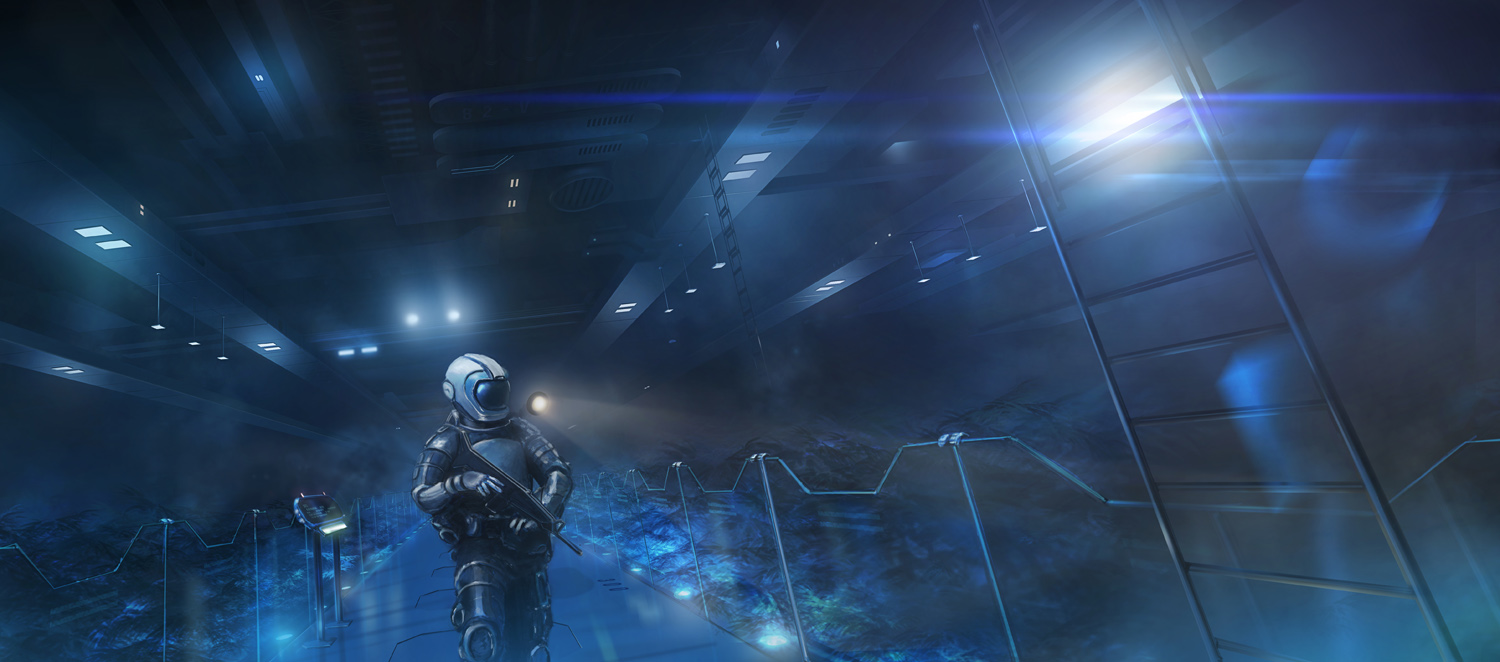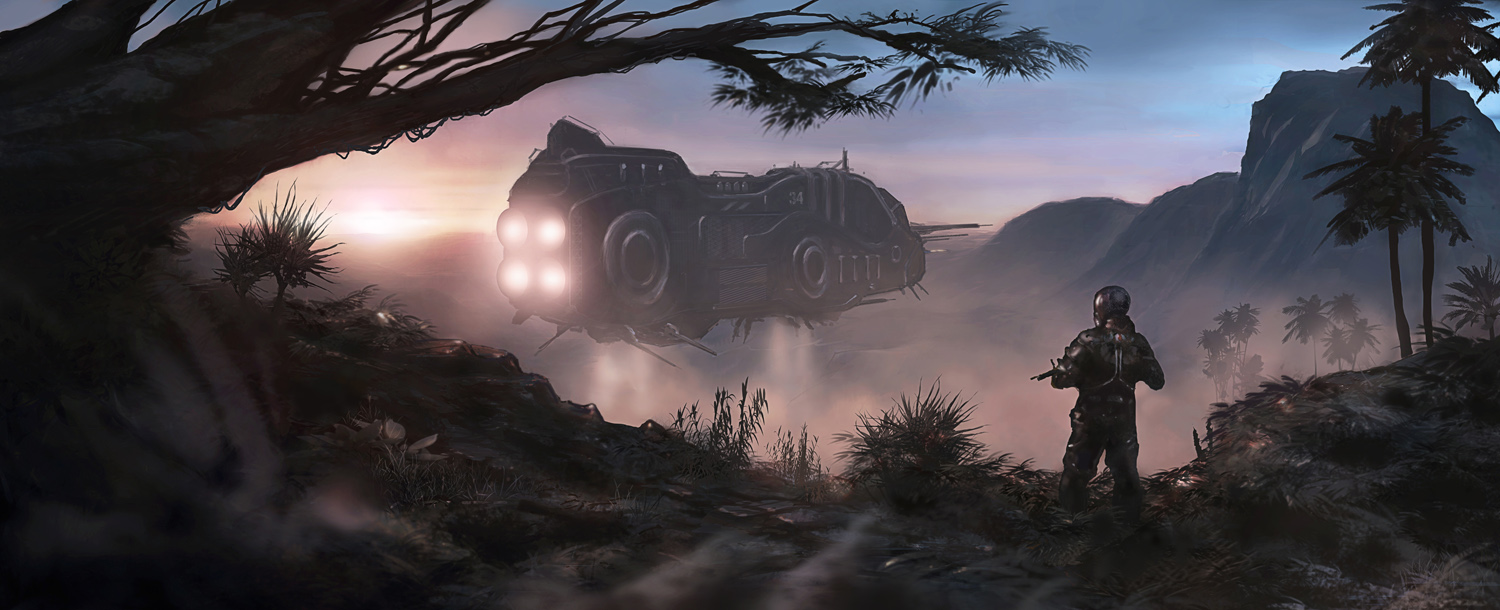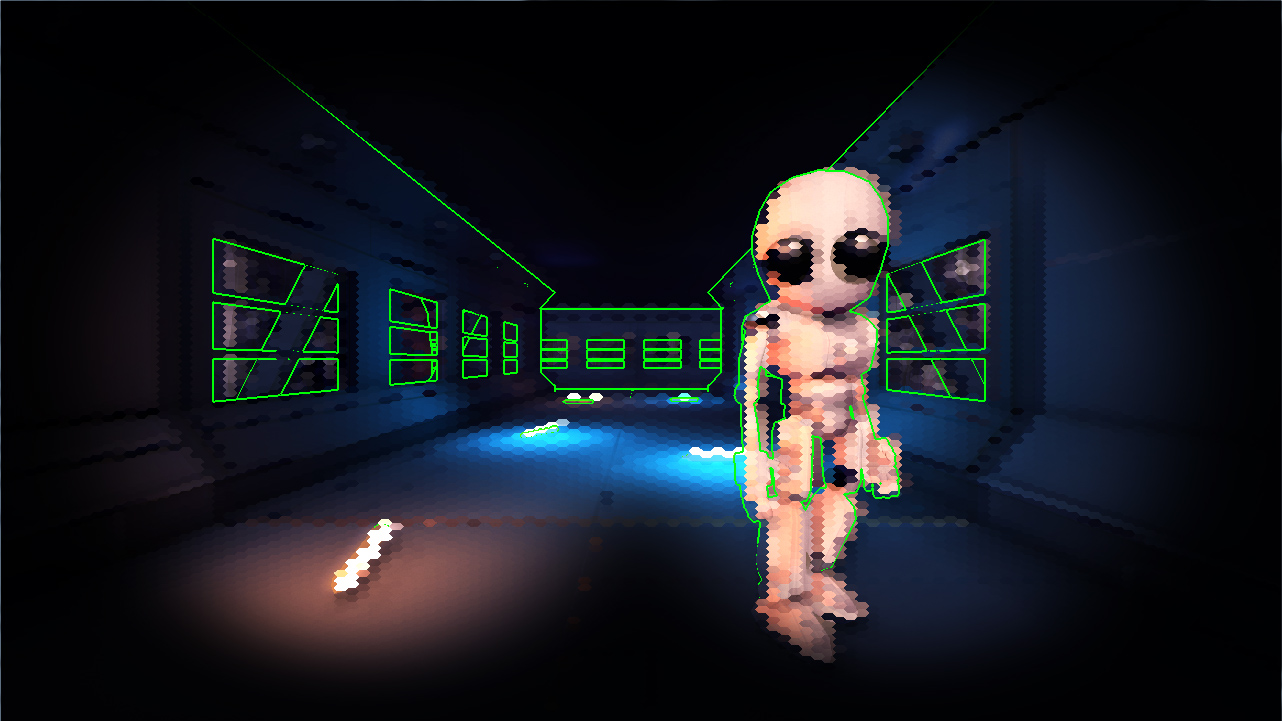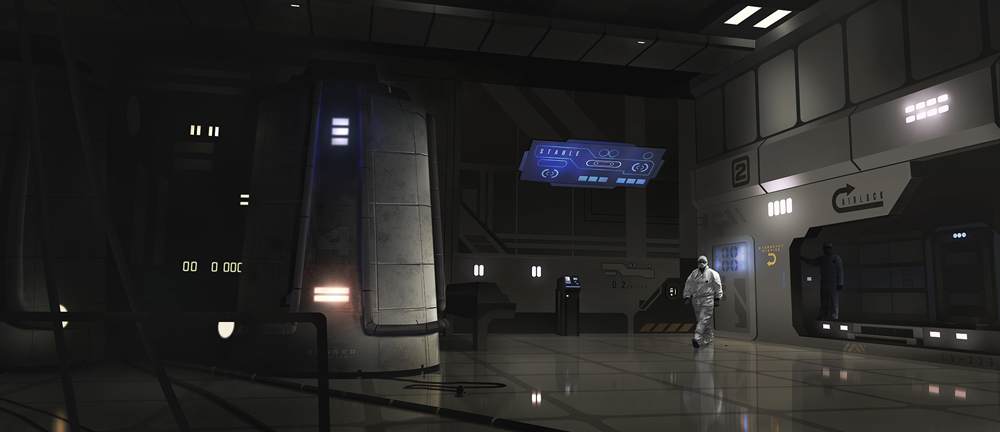Can you sell the idea to me as someone who never played theme hospital or dungeon keeper?
Yes yes I can. But it's really hard. This question always stumps me. Annoyingly it's the one journalists always ask. It's like asking "describe the planet earth"... But here goes.
The reason why you will love this game is it rewards your creativity. It allows you to play, plan and manage, without being a spreadsheet or dense and incomprehensible, but it will have the depth to keep you on your toes and the detail to make every play a unique tale of bitter survival.
The look of Maia in first person is quite striking, how did you arrive at it?
I always wanted the view to be pixelated. But I knew if I sent out what looked like screens of Doom people would hate it. I wanted something special so started from scratch.
The technology in the game is 1970s so I thought what would computer vision look like if you did it with science from the era.
Inspired by Terry Cavanagh's latest game I made the pixels hexagons. That immediately made things look cool.
Computer visions like kinect also usually use a depth buffer. That shows the distance of a pixel from the camera. So I used the depth of the scene to warp the colours and detect the edges of objects for the green lines. Much like the vision in our own eyes, I sample the colours and the value of the image at different resolutions. So although the colours are huge hexes, you can still see the detail in the scene.
I then thought the Imps should see in 3d. So I offset the red and blue hex samples, and we ended up with this:
Also, you mention offsetting the blue and red - does this mean if you were to wear old fashioned 3D glasses you'd get an illusion of depth?
Just tried it. I now feel very very nauseous.
Will there be interactivity in first-person mode?
In the first person mode you will be able to do most the things that the computer you possessed can do.
Possess a IMP and go digging, possess a turret and defend your base from invaders or even possess a door and.. well... annoy people.
How hard will Maia be? Will it be a snooze fest, like Gnomorria currently is as soon as you halve a halfway outfitted squad or will it be more like Dwarf Fortress, where FUN is guaranteed. Can you elaborate?
The difficulty of the game won't be measured by a single slider, but a by a selection of different factors. Underneath that there will be hundreds of small variables that tweak the world's simulations in subtle but dangerous ways. Tweaking the amount of sunlight might give you more solar power, but make plants grow faster and feed more wildlife. Increasing the amount of volcanic activity means more lava and earthquakes, but will make precious minerals common. Everything will have a trade off.
Of course, more casual users will be able to pick some standardised settings to make a less threatening environment.
What type of random occurrences are you planning for the game? Are you going for something that just happens that the player can't control? Or more along the lines of random things happening because you failed to protect against it?
With the big, interconnected simulation I am planning there are lots of things that might occur, seemingly without warning. An unbalanced ecosystem might leave you suddenly with a lot of hungry predators invading your colony.
There are some things that will be almost entirely random however. Earthquakes, breaking through into a lava flows/underground lakes, meteor strikes and solar flares are three things that the player just won't be able to plan for!
How much detail and depth will you have? Will it have a lot of replayability?
I'm hoping to have lots of features and depth. I think the simulation will really help that, without knowing what to expect things will develop very differently every time the game is played.
I'm hoping to make a tech tree that is nonlinear and in some places somewhat random. The research outcomes aren’t be predictable so will keep you on your toes and creating new gameplay styles.
One of the reasons for the KS is because I just want to make tons and tons of content.
How does game start? What supplies do we get?
You will start with a functioning airlock to the exterior and a small room. In a standard mission, you will have supplies for twenty or so in game days, ten colonists and five IMP bots.
Colonists do they have skills?
They will, but it won't be advertised to the player via a GUI. You will need to keep an eye on what they like doing and what they do fastest to figure out what their specific skill set is.
Will colonists have personalities?
The colonists will have a whole range of emotions and personalities.
What other bots can I make?
Currently just the IMP bot. However there will be more, whether they are designed by us or build by the player depends on us hitting the stretch goal.
Will it be possible(even if more difficult) to set up your colony above ground?
Yes. The surface will be incredibly hostile. The risks are massive, but also the rewards.
Are there going to be day/night cycles above ground?
Yep! It will affect the wildlife, plant growth, solar output etc. I'm even simulating cloud coverage (you can see them crawling across the opening shot of the trailer).
If you dig a massive open cast pit, will creatures/plants from the surface colonize/spread to the new surface level?
The layers are separated by a large distance. So you can't dig down in the way you can in a block based game. Creatures and plants will spread into your base though. You will need to be careful about how you place your lights to minimize it!
So would you be able to flatten a large area on the surface, by removing a hill/filling in depressions?
Currently the surface is flat but eventually it will be bumpy and I'll be adding a way to flatten it out. There will also be some things that will superficially create pits. Such as archaeological digs and meteorite impact craters.
Will colonists age, and eventually die of old age?
Yeah that is the plan. They currently get old and die, but we still need the graphics to show that happening. Will probably blend between textures and models eventually.
Will there be babies/children? If so will they be somewhat protected from the various dangers, or will they be as fully vulnerable to bad things as in DF?
This is a major issue, not because of game ratings or censorship, but more I am worried that it might break the tone of the humour somewhat. I want it to happen, but I might infer it... I'll find a way to make it fit.
Will there be immigration bringing in new colonists?
Immigration, will exist at the lower level difficulty modes.
Emigration?
Colonists may decide to leave. Wandering off out the airlock. I don't rate their chances.
What kinds of combat will Maia feature? Will there be different kinds of armor & weapons for the colonists/soldiers? I loved the hell out of Startopia, but the combat wasn't much more advanced than building as many security scuzzers as possible and I would love to see a similar game that had a more in depth combat strategy.
Currently we are going for two standard weapons for the colonists, a Browning high power and a Self loading Rifle. (They are standard issue British armaments of the 1970s and fit with the aesthetic, but hard wearing enough to be perfect for use in the future)
No plans for armour yet. Although the spacesuit will offer greater protection, and that can be upgraded.
There will be lots of strategy, with turrets, traps, airlocks and lockable doors etc.
Will there be a mode for Maia similar to My Pet Dungeon from Dungeon Keeper where you can just mess around and build whatever you want?
That is the core of the game. It's a fully sandbox environment!
There will be some mission scenarios to do too though, and a full story campaign if we hit the stretch goal.
With a chocolatey-voiced narrator I hope?
I would give the world for Richard Ridings to do voice over.
What is the ultimate goal or win condition in the game? To keep your people safe? To expand your colony? Or will it be an eternal state with small wins like in Sim City? If this is the case, what factors will enhance replayability? (I'm thinking Sim City disasters, terrain challenges etc.)
In a vanilla game there is no win state. In most cases something will eventually go wrong and everyone will die.
There will be some completable scenario missions that will have requisites, like researching a specific site on the surface, or establishing an exterior base.
If we hit the stretch goal, there will be a proper campaign with missions that have a narrative.
You mean, everyone will die with the exception of Marvin, who will just stand and rust for millions of years with a pain in all the diodes down his left side?
The original trailer was just going to be an IMP wondering about an empty colony complaining how all the lazy humans got themselves killed (when it was blatantly his fault).
Will there be some “end game” research.
Oh yes! It will be some pretty lofty stuff. I'm avoiding spoiling that just yet.
I remember you saying somewhere that the first person view for each or most aliens will be different, similar to what DK1 did. Does that mean different color-palettes/heights (again similar to what DK did) or bigger changes like for example sonar/heat/smell "vision"?
You can't possess the aliens (unless they are cybernetic(this is a potential research path(that is currently unlikely to be in the game unless we get way over the KS target))) With the robots/computers you possess there will eventually be very different views. The turret's and door's vision will be based on movement for example.
You mentioned Dwarf Fortress as one of the sources of inspiration for Maia. How similar will it be? I understand that it's impossible to reproduce in detailed 3D all the features of Dwarf Fortress (and also that it's not the aim), but still?
Yeah. I'd be foolish to even try to create a DF clone.
What I'm doing is trying to replicate the attention to detail that makes the game so unique rather than trying to replicate the game itself.
Of course there will be some pretty hefty bearded nods to the game too.
Is it like Black and White, but better? Can you fling stuff at stuff and watch the physics engine go haywire? Can I be a vengeful god?
You don't have direct interaction with stuff like in Black and White. But there is certainly plenty of space (and lava) for being a horrendous sadist.
I can't believe no-one has mentioned Populous yet, so here goes: Will there be an Armageddon spell/button in Maia?
Doesn't really fit the game, maybe as a cheat code! That would be amazing.
Do you have a rough estimate of the system requirements? It looks amazing, slightly too good for my computer.
Yeah a middle of the range gaming PC can play the game at 60fps easily, even my old laptop manages a playable 30fps.
Will there be a colour blind mode. Will the game be playable for disabled gamers?
I'm going to try to ensure that the game is playable for colour blind users. This might mean changing the values of the lights a bit and perhaps adding a few bits of special GUI for them.
For disabled gamers I'm trying to ensure that the game is 100% playable from the mouse alone. The game will also have full keyboard short-cuts and lots of customisable settings. If you have any special needs that you'd like catered for, please drop me an email and I'll work it into the design.
Why the name Maia?
Since we name our planets after gods I felt that it would be appropriate that we name any one that we colonize. Maia is an interesting name that has a firm routing in Ancient Greek and Roman Mythology.
How much background lore will there be to Maia? Will there be lots of juicy detail for us to pore over?
There sure will! I have a few writers who at chomping at the bit to help me flesh out the details of the mission and planet.
How long did Maia take?
It was a side project since early January. I've been picking at it for ages, but recently took it full time last month.
Will you be supporting linux from the beginning or do you plan to port later on?
I started thinking about Linux from the very start. I learnt a lot from the VVVVVV port. Also all the coding I did in AAA was multiplatform. My engine is pure C++ with a bit of SDL. Should work on Linux almost straight away.
Is it easy for you to make a Linux client ? what made you support Linux ?
Supporting Linux isn't all that hard when you've written your own engine in C++. If I didn't support it, it would only be out of laziness, and that just wouldn't do would it?
Linux is viable platform for games and any developer ignoring it is missing out on a huge market.
When you say "Open Data" for the modding community, does this mean that existing assets shipped with the game are public domain? Or does it mean that the assets can be utilized and modified only if shipped with a mod with the game? (hoping the former).
The assets will be easily decompilable and everything that can be will be editable for modders. I'll also release all my tools and scripts.
They will still be copyrighted though so not really public domain no. I won't rule that out for the future though.
Which games influenced Maia?
Lots of games. Dwarf Fortress, Dungeon Keeper, Theme Hospital, The Sims, Black and White, Space Station 13. But truth be told, I'm avoiding taking games as inspiration, or taking elements from them.
I'm finding a lot more inspiration in science fiction novels. Making the game is hard, but the real challenge is creating a world that stands on its own and that players can find their own narratives on.
How long did it take you to design Maia? Or is it a process that's been ongoing and developing for a long time?
I was working on a first person surreal horror game as my side project and I got creatively blocked. I started to think about turning it into a survival game, building a base in first person.
I got bogged down in complex tech and decided to start from scratch. Had a few sleepless nights thinking about the game's design. But was far too busy with VVVVVV and then my doctorate to consider making it.
I stewed on the game for a good 5 months, but I gave in to the temptation some time early this year and put together a few bits of code and took a screenshot. Everyone on my facebook got really excited. At that point I realised that I needed to make this game or I'd go nuts designing it in my head over and over.
 Did you ever play Startopia and will that have any influence on Maia? It seems very similar in form and function, plus the British humour element.
Did you ever play Startopia and will that have any influence on Maia? It seems very similar in form and function, plus the British humour element.
It blew a lot of peoples minds to find out that I've never played Startopia. I'd heard of it but never seen a video or screenshot.
Now that I know what it is, and made by ex-Bullfrog staff, I'm shocked that I'd never heard of it. I'm going to be setting some time aside after the Kickstarter to give it a good go.
Have you ever played the PC version of Lego Rock Raiders (1999)? Just asking because this kinda looks like a modern re-imagining. Sci-fi management game + caves, lava, roads, buildings and a switch to first person view.
No, but it looks fun though! Tried to track down a copy, but not sure I can get it to run on a modern OS. If anyone can, let me know.
What do you think is behind the recent popularity of the retro aesthetic (1970s and 1980s) among science fiction games? (For example, your game, Routine, or even Mass Effect)
Mass Effect started with the aesthetic, but failed to run with it. It was a cursory nod at best. The nonsensical lens flares irritated me.
Film making in the 70's was still an art. Cinematography was key. It's what makes films look good, not special/visual effects. I really wanted to make my game to the same standards that a 1970s director would shoot his film. Even down to simulating the lens and the film colour response.
The Routine guys are going for a slightly more 80's look. But it is really coming along great, hope they take it as far as they can.
RIP Bullfrog. We're going to get Dungeon Keeper III one of these years ...
Sadly EA have 0 respect for the IP. They farmed it out for a terrible Chinese World of Warcraft clone. I threw up in my mouth the first time I saw it.
Any reason for the 70's cinema inspiration? and how do you want that to come through in the game?
Apart from the visual aesthetic, in terms of the game world the 1970's influence will show though at a fundamental level. I figured that if I were building things from scratch, say a computer, with limited resources, the best I could do would probably be something at that level of technology. You can build a cathode ray tube in your garage, an LCD needs a whole chemical plant!
Not to mention, 70's gadgets last forever, which is important when you can't build spares.
What is your view on Greenlight and Steam as a distribution platform for Indies?
It's great! Hopefully they can fix the kinks in Greenlight. The comment system is quite a mess at the moment and the discoverability of games could do with a boost. Perhaps by incentivising people to find interesting games.
How/When did you start programming? What got you into game engines?
I used to try to make games when I was a kid in Basic, but they were crap and I hated the fact I couldn't make the graphics.
When I was at Uni studying "Computer Animation and Visualisation" I enjoyed coding as a welcome break from all the art side of things. Ended up doing an internship at Natural motion (who make Euphoria, and other cool games tech).
I then attempted to create a game engine for my final project of my degree. It was way too ambitious, but I came away with something pretty cool.
What's with the strange 100,042 goal?
Get yourself this gift for the Holidays.
What is your favourite game of all time?
I really couldn't choose!
Dungeon Keeper, Theme Hospital, Metro 2033, Red Alert, Stalker, Zenoclash, Morrowind, Half Life, Company of Heroes and Mirrors Edge are all games that people NEED to play.


















